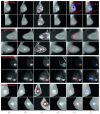Local Binary Patterns Descriptor Based on Sparse Curvelet Coefficients for False-Positive Reduction in Mammograms
- PMID: 30356422
- PMCID: PMC6178513
- DOI: 10.1155/2018/5940436
Local Binary Patterns Descriptor Based on Sparse Curvelet Coefficients for False-Positive Reduction in Mammograms
Abstract
Breast Cancer is the most prevalent cancer among women across the globe. Automatic detection of breast cancer using Computer Aided Diagnosis (CAD) system suffers from false positives (FPs). Thus, reduction of FP is one of the challenging tasks to improve the performance of the diagnosis systems. In the present work, new FP reduction technique has been proposed for breast cancer diagnosis. It is based on appropriate integration of preprocessing, Self-organizing map (SOM) clustering, region of interest (ROI) extraction, and FP reduction. In preprocessing, contrast enhancement of mammograms has been achieved using Local Entropy Maximization algorithm. The unsupervised SOM clusters an image into number of segments to identify the cancerous region and extracts tumor regions (i.e., ROIs). However, it also detects some FPs which affects the efficiency of the algorithm. Therefore, to reduce the FPs, the output of the SOM is given to the FP reduction step which is aimed to classify the extracted ROIs into normal and abnormal class. FP reduction consists of feature mining from the ROIs using proposed local sparse curvelet coefficients followed by classification using artificial neural network (ANN). The performance of proposed algorithm has been validated using the local datasets as TMCH (Tata Memorial Cancer Hospital) and publicly available MIAS (Suckling et al., 1994) and DDSM (Heath et al., 2000) database. The proposed technique results in reduction of FPs from 0.85 to 0.02 FP/image for MIAS, 4.81 to 0.16 FP/image for DDSM, and 2.32 to 0.05 FP/image for TMCH reflecting huge improvement in classification of mammograms.
Figures

















Similar articles
-
Computer aided detection of clusters of microcalcifications on full field digital mammograms.Med Phys. 2006 Aug;33(8):2975-88. doi: 10.1118/1.2211710. Med Phys. 2006. PMID: 16964876
-
Detection of mass regions in mammograms by bilateral analysis adapted to breast density using similarity indexes and convolutional neural networks.Comput Methods Programs Biomed. 2018 Mar;156:191-207. doi: 10.1016/j.cmpb.2018.01.007. Epub 2018 Jan 11. Comput Methods Programs Biomed. 2018. PMID: 29428071
-
Mass detection in digital breast tomosynthesis: Deep convolutional neural network with transfer learning from mammography.Med Phys. 2016 Dec;43(12):6654. doi: 10.1118/1.4967345. Med Phys. 2016. PMID: 27908154 Free PMC article.
-
Needs assessment for next generation computer-aided mammography reference image databases and evaluation studies.Int J Comput Assist Radiol Surg. 2011 Nov;6(6):749-67. doi: 10.1007/s11548-011-0553-9. Epub 2011 Mar 30. Int J Comput Assist Radiol Surg. 2011. PMID: 21448711 Review.
-
Methods Used in Computer-Aided Diagnosis for Breast Cancer Detection Using Mammograms: A Review.J Healthc Eng. 2020 Mar 12;2020:9162464. doi: 10.1155/2020/9162464. eCollection 2020. J Healthc Eng. 2020. PMID: 32300474 Free PMC article. Review.
References
-
- Kanadam K. P., Chereddy S. R. Mammogram classification using sparse-ROI: a novel representation to arbitrary shaped masses. Expert Systems with Applications. 2016;57:204–213. doi: 10.1016/j.eswa.2016.03.037. - DOI
-
- Bruno D. O. T., do Nascimento M. Z., Ramos R. P., et al. LBP operators on curvelet coefficients as an algorithm to describe texture in breast cancer tissues. Expert Systems with Applications. 2016;55:329–340. doi: 10.1016/j.eswa.2016.02.019. - DOI
MeSH terms
LinkOut - more resources
Full Text Sources
Medical
Miscellaneous

